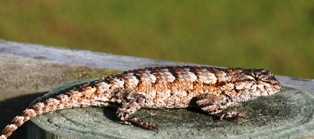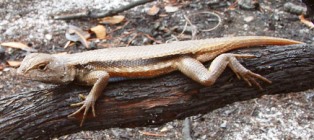Discover Florida Nature
It's time to explore the natural Florida


|
|
|
|
|
Florida has several lizard species that are easy to find and interesting
to watch. Amazingly many lizards can cast off their tails at will when
suddenly molested or threatened. If a predator grabs a lizard by its
tail, the tail will break off immediately. The place where it breaks is
pre-determined by a weak point in the vertebrae. The muscles in the tail
are so arranged that they will separate neatly. The detached tail
continues to wiggle, giving the predator the impression that it is
holding onto a fighting animal. The regenerated tail of a lizard has no
bones and does not bear the stripes or markings of the original tail.
Lizard tails may be regenerated again and again. For the most part
lizards are insect eaters. A lizard moves forward by advancing
diagonally opposite legs at the same time. This sequence causes the
lizard to wiggle its body from side to side as it walks or runs! The
wiggle in the lizard's walk is the forerunner of limbless motion, the
undulating movement that propels snakes. It serves as a reminder that
snakes evolved from lizards or lizard like animals. The
sand skink is an intermediate form. This
creature has limbs, but folds them out of the way and moves through sand
with a snakelike motion. Curly-tailed
Lizard- The curly tailed, or lion lizard as it is sometimes
called is easily recognized by a long banded tail that curls over the
back. This lizard has a glossy look, though its scales are rough. Lion
lizards are brownish-green-gray with considerably barring and mottling.
This lizard's underside is pale yellow. Full-grown males have a bulkier
head than the females. Males have throat fan, but this is hardly ever
seen. Curly-tailed lizards are commonly seen, even in urban areas, but
usually near the beach, where they often use rocks for
cover. Curly-tailed lizards bury themselves in the sand to sleep at
night, but during the day they emerge to sun themselves to stimulate
their metabolism before hunting insects. They lay approximately three
eggs in a batch, usually adhering to rocky surfaces. Hatchlings emerge
in July, August and September. It is reported that lion lizards lay
several batches of eggs during the season. Hatchlings have a bright
orange throat that lasts only for the first three or four days. Lion
lizards can become very tame and will learn to expect food from humans.
They prefer high protein snacks such as eggs, cheese or meat. This
charming lizard, found all over the Bahamas, and some West Indie
Islands, has been introduced into southeast Florida. The curly-tailed
lizard is particularly vulnerable to predation by housecats. This lizard
got its name because it curls its tail like a lion or scorpion when
approached. Curly-tailed
Lizard- The curly tailed, or lion lizard as it is sometimes
called is easily recognized by a long banded tail that curls over the
back. This lizard has a glossy look, though its scales are rough. Lion
lizards are brownish-green-gray with considerably barring and mottling.
This lizard's underside is pale yellow. Full-grown males have a bulkier
head than the females. Males have throat fan, but this is hardly ever
seen. Curly-tailed lizards are commonly seen, even in urban areas, but
usually near the beach, where they often use rocks for
cover. Curly-tailed lizards bury themselves in the sand to sleep at
night, but during the day they emerge to sun themselves to stimulate
their metabolism before hunting insects. They lay approximately three
eggs in a batch, usually adhering to rocky surfaces. Hatchlings emerge
in July, August and September. It is reported that lion lizards lay
several batches of eggs during the season. Hatchlings have a bright
orange throat that lasts only for the first three or four days. Lion
lizards can become very tame and will learn to expect food from humans.
They prefer high protein snacks such as eggs, cheese or meat. This
charming lizard, found all over the Bahamas, and some West Indie
Islands, has been introduced into southeast Florida. The curly-tailed
lizard is particularly vulnerable to predation by housecats. This lizard
got its name because it curls its tail like a lion or scorpion when
approached. Southern
Fence Lizard- The Southern Fence Lizard is a common sight in
many Florida landscapes. The southern fence lizard is approximately 7
inches in length at maturity. It has a rough scaled body that is gray
with black and light gray zigzag patterns along its back. Color
variations occur giving rise to individuals that are gray to brown with
heavy striping or little if any striping. Adult males have brilliant
patches of metallic blue along the undersides of their bellies and
throats, and may be very dark gray in color. During mating and
territorial displays males can be seen doing pushups to show off their
blue undersides. Southern fence lizards are diurnal and can be found
hunting prey throughout the day. Fence lizards do not run after their
prey, but rather sit and wait for it to stroll by and then pounce upon
it. Their diet consists of ants, crickets, grasshoppers, spiders,
centipedes, snails and beetles. Ant hills are a favorite hunting ground.
If you catch this lizard by the tail, it will easily break off and
continue to wiggle in your hand while the tail-less animal gets away.
The tail does regenerate in time. The Southern Fence lizard's natural
habitat is pine flatwoods, xeric hammocks and longleaf pine, or turkey
oak. In the home landscape they can be found climbing on fences and
logs, basking in the sun on rocks, and searching for food on wooden
decks, garden borders, and trees. Breeding occurs in early spring. Six
to ten eggs are laid in a shallow nest at the base of a clump of
vegetation or rotting log. A favorite nesting sight is sawdust. Eggs
begin to hatch in early June and throughout the summer months into early
fall. Southern
Fence Lizard- The Southern Fence Lizard is a common sight in
many Florida landscapes. The southern fence lizard is approximately 7
inches in length at maturity. It has a rough scaled body that is gray
with black and light gray zigzag patterns along its back. Color
variations occur giving rise to individuals that are gray to brown with
heavy striping or little if any striping. Adult males have brilliant
patches of metallic blue along the undersides of their bellies and
throats, and may be very dark gray in color. During mating and
territorial displays males can be seen doing pushups to show off their
blue undersides. Southern fence lizards are diurnal and can be found
hunting prey throughout the day. Fence lizards do not run after their
prey, but rather sit and wait for it to stroll by and then pounce upon
it. Their diet consists of ants, crickets, grasshoppers, spiders,
centipedes, snails and beetles. Ant hills are a favorite hunting ground.
If you catch this lizard by the tail, it will easily break off and
continue to wiggle in your hand while the tail-less animal gets away.
The tail does regenerate in time. The Southern Fence lizard's natural
habitat is pine flatwoods, xeric hammocks and longleaf pine, or turkey
oak. In the home landscape they can be found climbing on fences and
logs, basking in the sun on rocks, and searching for food on wooden
decks, garden borders, and trees. Breeding occurs in early spring. Six
to ten eggs are laid in a shallow nest at the base of a clump of
vegetation or rotting log. A favorite nesting sight is sawdust. Eggs
begin to hatch in early June and throughout the summer months into early
fall. Florida
Scrub Lizard- The Florida scrub lizard is about five-inches
long, and grey-brown with a thick dark brown stripe running down the
side of the body from the neck to the base of the tail. There are 8-10
dark, wavy bars on the back. The scales are spiny, making the skin look
rough, not smooth and shiny. Adult males have light blue patches on
the sides of the belly and a blue throat. Florida Scrub lizards can
frequently be found resting on the shade of a rosemary bush or foraging
in leaf litter for insects. Although primarily terrestrial, they will
climb trees to avoid capture. The Florida Scrub Lizard is a "sit and
wait" predator that eats ants, beetles, spiders, and other small
arthropods Unlike the fence lizard, the scrub lizard displays a high
degree of habitat specificity, occurring as unjointed populations in
strict association with the major sand scrub ridges of Florida. The
healthiest populations of Florida Scrub lizards are found on the Mt.
Dora Ridge in northern peninsular Florida, on which significant remnants
of scrub habitat are preserved in the
Ocala National Forest.
Populations also occur on the Lake Wales Ridge of central Florida and
the Atlantic Coastal Ridge, but the status of these populations is less
secure. Florida
Scrub Lizard- The Florida scrub lizard is about five-inches
long, and grey-brown with a thick dark brown stripe running down the
side of the body from the neck to the base of the tail. There are 8-10
dark, wavy bars on the back. The scales are spiny, making the skin look
rough, not smooth and shiny. Adult males have light blue patches on
the sides of the belly and a blue throat. Florida Scrub lizards can
frequently be found resting on the shade of a rosemary bush or foraging
in leaf litter for insects. Although primarily terrestrial, they will
climb trees to avoid capture. The Florida Scrub Lizard is a "sit and
wait" predator that eats ants, beetles, spiders, and other small
arthropods Unlike the fence lizard, the scrub lizard displays a high
degree of habitat specificity, occurring as unjointed populations in
strict association with the major sand scrub ridges of Florida. The
healthiest populations of Florida Scrub lizards are found on the Mt.
Dora Ridge in northern peninsular Florida, on which significant remnants
of scrub habitat are preserved in the
Ocala National Forest.
Populations also occur on the Lake Wales Ridge of central Florida and
the Atlantic Coastal Ridge, but the status of these populations is less
secure. |
|
|
Advertise | Privacy Statement | Dog Encyclopedia | Video |Contact | Alaska Nature |
|